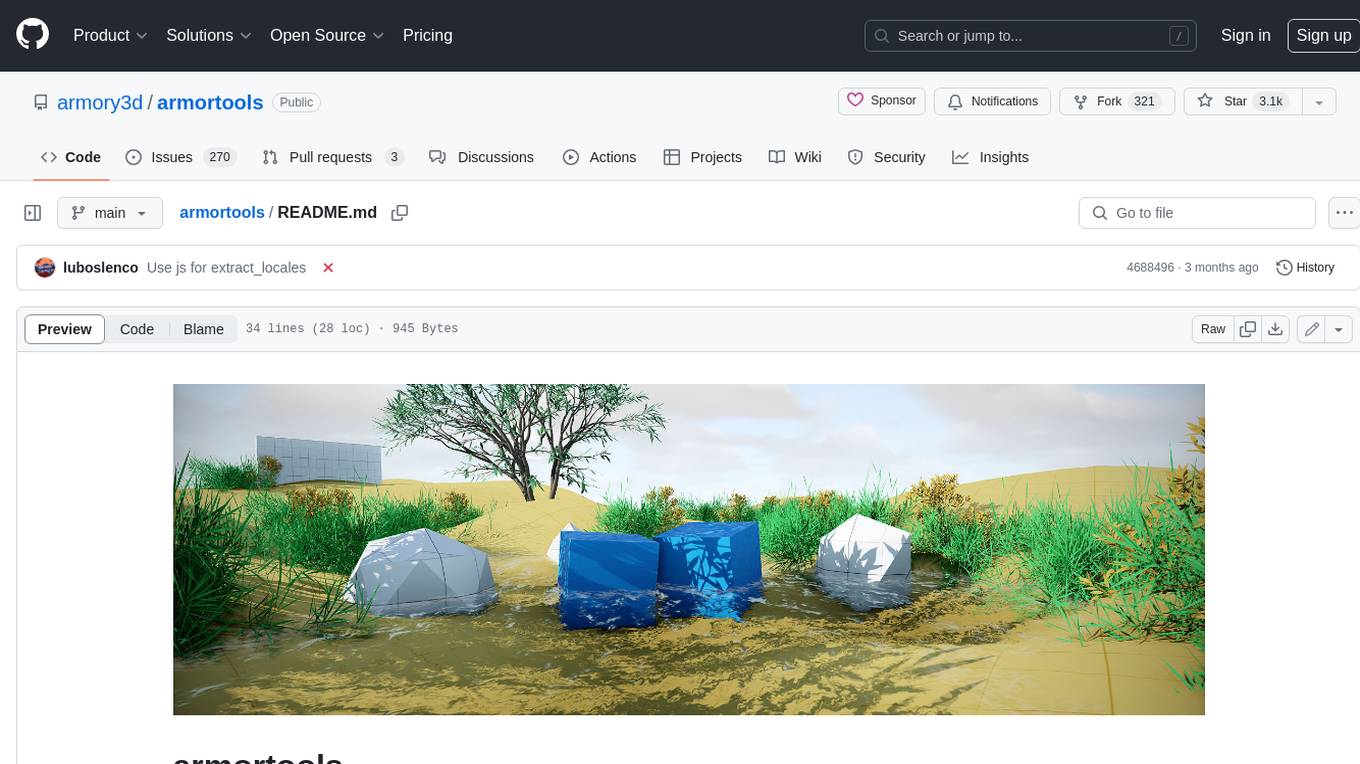
aircraft
None
Stars: 169
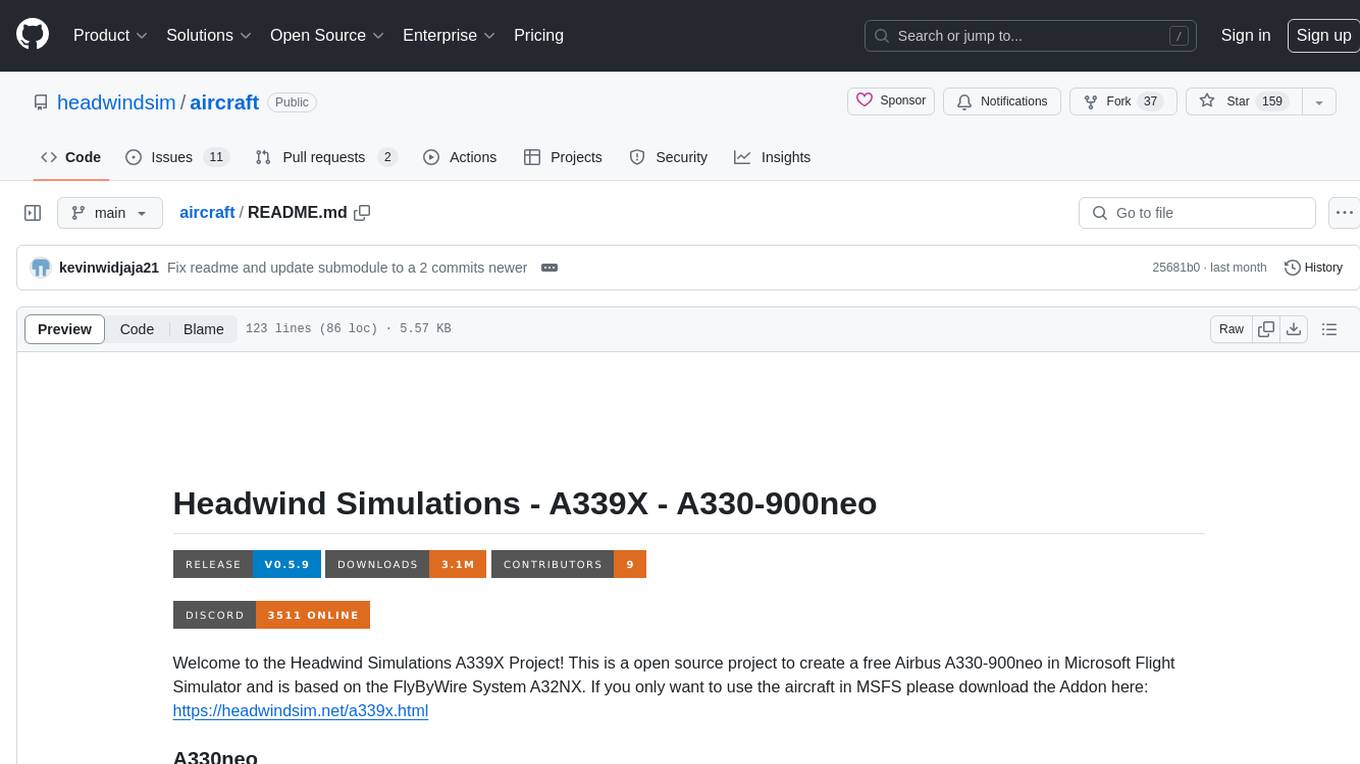
Headwind Simulations A339X - A330-900neo is an open-source project aimed at creating a free Airbus A330-900neo for Microsoft Flight Simulator. The project is based on the FlyByWire System A32NX and offers a detailed simulation of the A330-941 model with various components like engines, FMS, ACAS, ATC, and more. Users can build the aircraft using Docker and node modules, and the package can be easily integrated into MSFS. The project is part of a collaborative effort with other open-source projects contributing to the aircraft's systems, cockpit, sound, and 3D parts. The repository is dual-licensed under GNU GPLv3 for textual-form source code and CC BY-NC 4.0 for artistic assets, ensuring proper usage and attribution of the content.
README:
Welcome to the Headwind Simulations A339X Project! This is a open source project to create a free Airbus A330-900neo in Microsoft Flight Simulator and is based on the FlyByWire System A32NX. If you only want to use the aircraft in MSFS please download the Addon here: https://headwindsim.net/a339x.html
Model A330-941
Engine RR TRENT 7000
APU GTCP331-350C
FMS Honeywell Release P5A
FWC Std. H2F9C
RA Honeywell ALA-52B
TAWS Honeywell EGPWS
ACAS Honeywell TPA-100B
ATC Honeywell TRA-67A
MMR Honeywell MMR
WXR Honeywell RDR-4000
The present aircraft setup is either being simulated or targeted. It's important to keep in mind that this setup could be altered in the future as the A339X initiative develops and transforms.
Make sure docker are installed. Prefferably with WSL2 backend.
1. First, run following command on powershell. This will install the A32NX docker images and node modules.
For powershell:
.\scripts\dev-env\run.cmd ./scripts/setup.shFor Git Bash/Linux:
./scripts/dev-env/run.sh ./scripts/setup.shFor powershell:
.\scripts\dev-env\run.cmd ./scripts/copy_a339x.sh
.\scripts\dev-env\run.cmd ./scripts/copy_a333x.sh
.\scripts\dev-env\run.cmd ./scripts/copy_su95x.shFor Git Bash/Linux:
./scripts/copy_a339x.sh
./scripts/copy_a333x.sh
./scripts/copy_su95x.shFor powershell:
.\scripts\dev-env\run.cmd ./scripts/build_a339x.sh
.\scripts\dev-env\run.cmd ./scripts/build_a333x.sh
.\scripts\dev-env\run.cmd ./scripts/build_su95x.shFor Git Bash/Linux:
./scripts/dev-env/run.sh ./scripts/build_a339x.sh
./scripts/dev-env/run.sh ./scripts/build_a333x.sh
./scripts/dev-env/run.sh ./scripts/build_su95x.sh4. The package is now ready to use. Copy the folder "headwind-aircraft-a330-900" to your CommunityPackage folder in MSFS.
Open Source Projects contributing to the realisation of this MSFS A330-900 Neo :
Systems, Cockpit, Cockpit texture, Sound: FlyByWire - https://github.com/flybywiresim
Engine Sound: FTSiM+ - https://www.ftsimplus.com
Cockpit 3D parts, learning: Project Mega Pack - https://github.com/Project-Mega-Pack
This repository and its contents are dual-licensed, with a unique set of terms applied to the original textual-form source code and the artistic assets, respectively.
The original textual-form source code in this repository is licensed under the GNU General Public License version 3 (GNU GPLv3). Compiled artifacts generated from this source code also fall under the GNU GPLv3 license.
A copy of the GNU GPLv3 can be found in the LICENSE file in this repository or online.
The artistic assets within this repository, including models and textures, are licensed under a Creative Commons Attribution-NonCommercial-ShareAlike 4.0 International License (CC BY-NC 4.0).
You can view the full text of the CC BY-NC 4.0 license here.
The Project Mega Pack A330, the FlyByWire Simulations A32NX, and the Headwind Simulations A339X were all created under Microsoft's "Game Content Usage Rules" using assets from Microsoft Flight Simulator 2020. They are neither endorsed by nor affiliated with Microsoft.
The A330neo model used in this project is based on the work of Shervin Ahooraei from Project Sky. It is not open source, but we have been granted explicit permission to use it. All rights and credits for this model belong to Shervin Ahooraei. The model cannot be copied, modified, or distributed without his direct permission.
We are not affiliated, associated, authorized, endorsed by, or in any way officially connected with the Airbus brand, or any of its subsidiaries or its affiliates.
Content within distribution packages built from the sources in this repository are licensed as follows:
- Original source code or compiled artifacts from Headwind Simulations: GNU GPLv3.
- Original 3D assets from Headwind Simulations: CC BY-NC 4.0.
- Assets covered by the "Game Content Usage Rules": Under the license granted by those rules.
- A330neo model: Not open source, used with explicit permission from Shervin Ahooraei of Project Sky.
Please respect these licenses and attributions when using content from this repository.
For Tasks:
Click tags to check more tools for each tasksFor Jobs:
Alternative AI tools for aircraft
Similar Open Source Tools

aircraft
Headwind Simulations A339X - A330-900neo is an open-source project aimed at creating a free Airbus A330-900neo for Microsoft Flight Simulator. The project is based on the FlyByWire System A32NX and offers a detailed simulation of the A330-941 model with various components like engines, FMS, ACAS, ATC, and more. Users can build the aircraft using Docker and node modules, and the package can be easily integrated into MSFS. The project is part of a collaborative effort with other open-source projects contributing to the aircraft's systems, cockpit, sound, and 3D parts. The repository is dual-licensed under GNU GPLv3 for textual-form source code and CC BY-NC 4.0 for artistic assets, ensuring proper usage and attribution of the content.
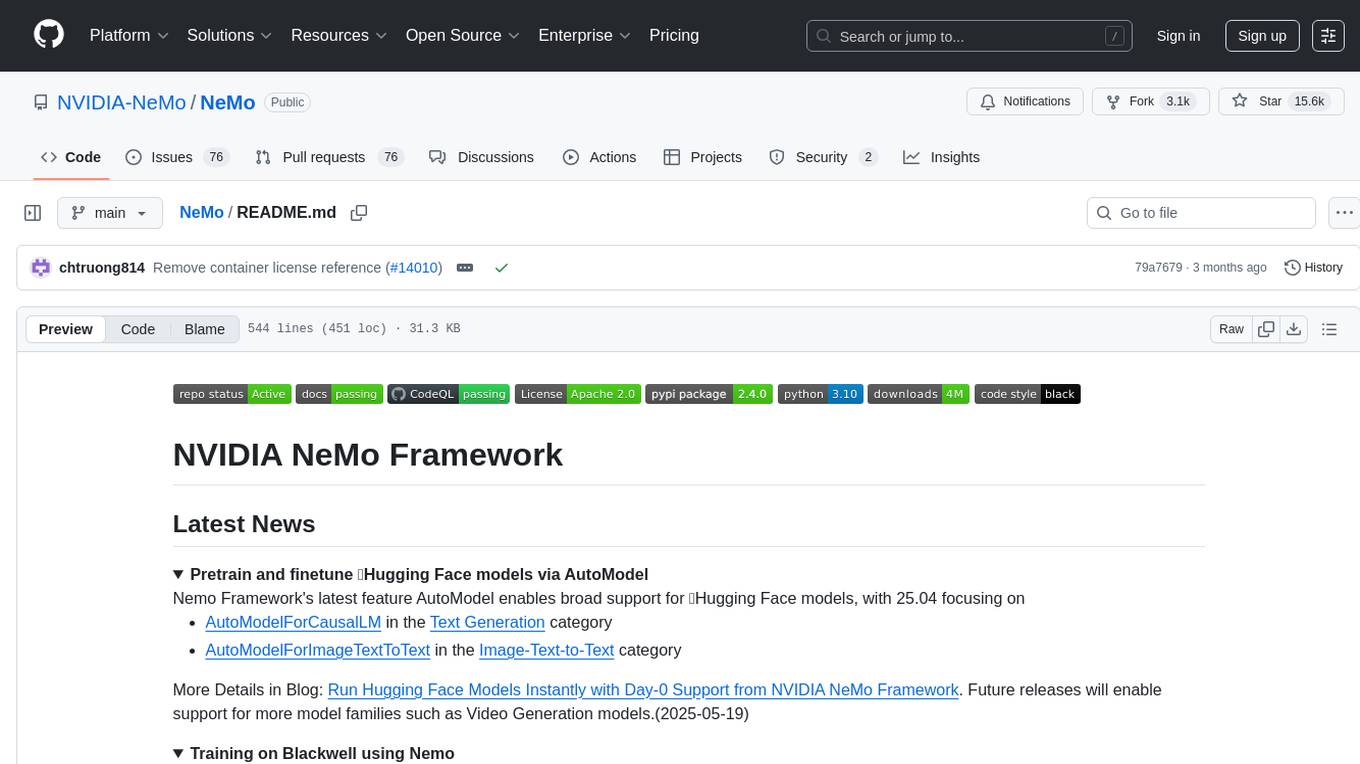
NeMo
NVIDIA NeMo Framework is a scalable and cloud-native generative AI framework built for researchers and PyTorch developers working on Large Language Models (LLMs), Multimodal Models (MMs), Automatic Speech Recognition (ASR), Text to Speech (TTS), and Computer Vision (CV) domains. It is designed to help you efficiently create, customize, and deploy new generative AI models by leveraging existing code and pre-trained model checkpoints.
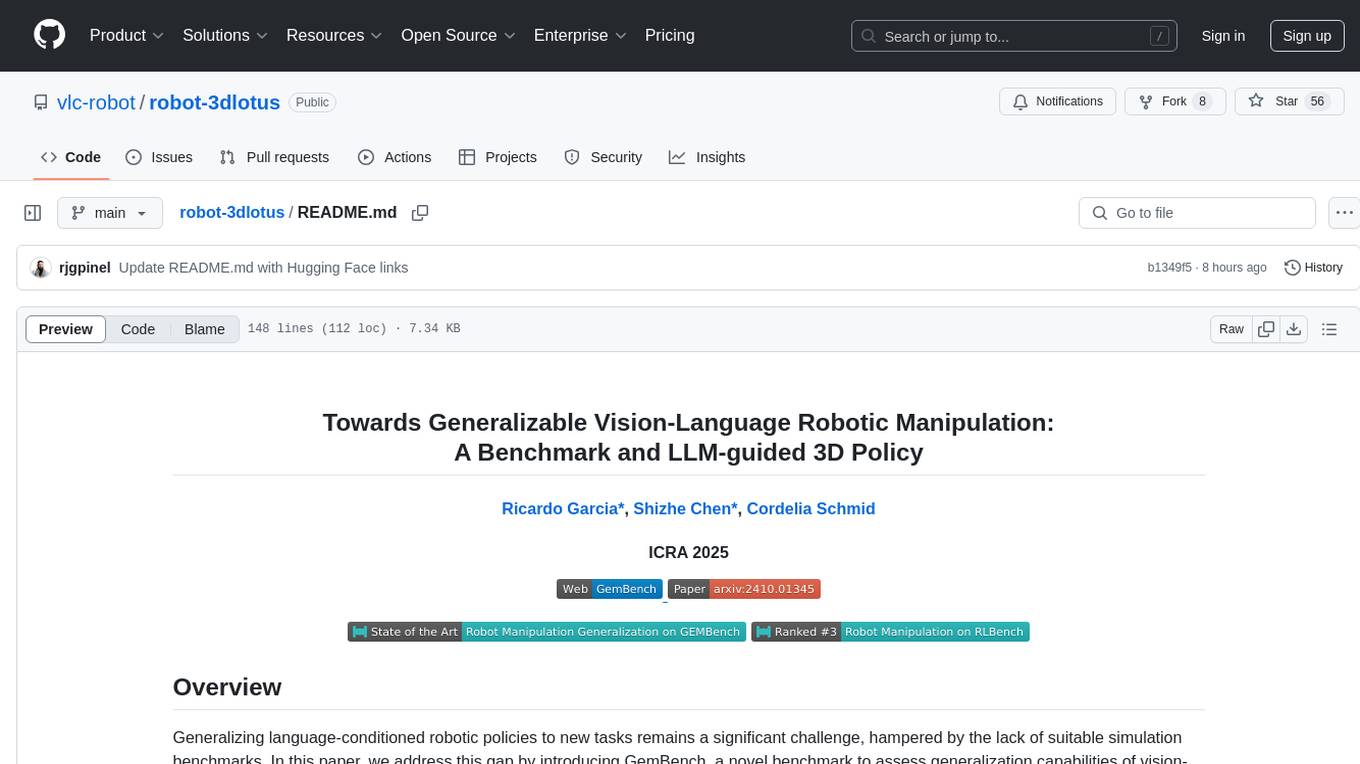
robot-3dlotus
Towards Generalizable Vision-Language Robotic Manipulation: A Benchmark and LLM-guided 3D Policy is a research project focusing on addressing the challenge of generalizing language-conditioned robotic policies to new tasks. The project introduces GemBench, a benchmark to evaluate the generalization capabilities of vision-language robotic manipulation policies. It also presents the 3D-LOTUS approach, which leverages rich 3D information for action prediction conditioned on language. Additionally, the project introduces 3D-LOTUS++, a framework that integrates 3D-LOTUS's motion planning capabilities with the task planning capabilities of LLMs and the object grounding accuracy of VLMs to achieve state-of-the-art performance on novel tasks in robotic manipulation.
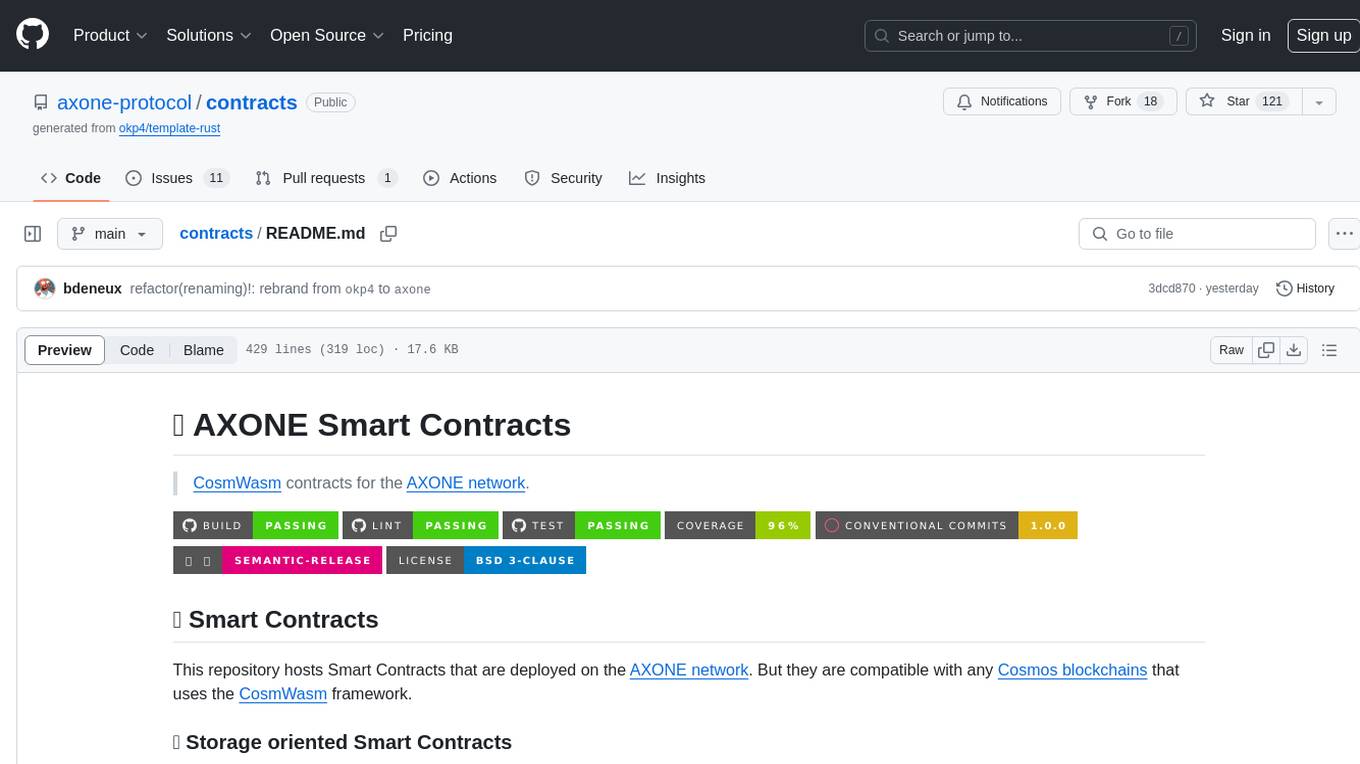
contracts
AXONE Smart Contracts repository hosts Smart Contracts for the AXONE network, compatible with any Cosmos blockchains using the CosmWasm framework. It includes storage, sovereignty, and resource management oriented Smart Contracts. Each contract has different functionalities and maturity stages, with detailed tech documentation and emojis indicating maturity levels. The repository provides tools for building, testing, deploying, and interacting with Smart Contracts, along with guidelines for contributing and community engagement.
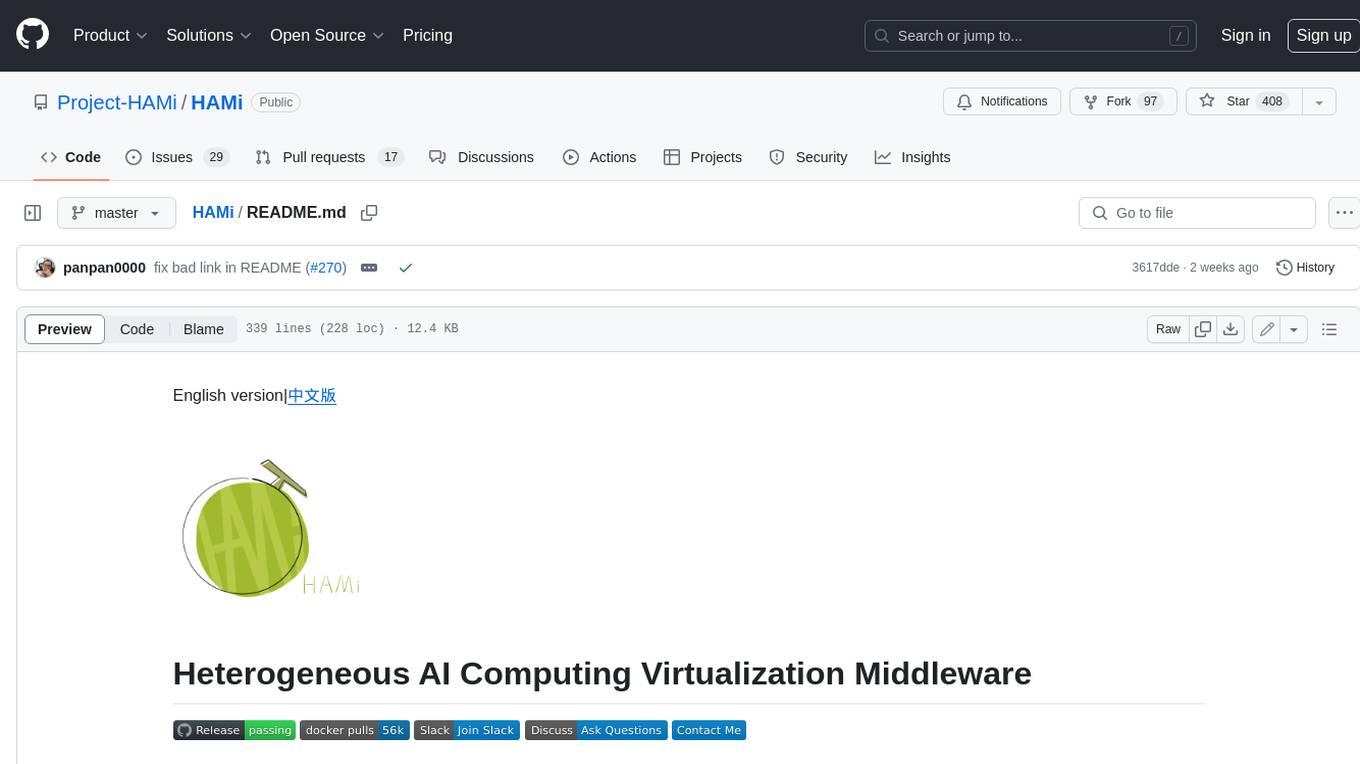
HAMi
HAMi is a Heterogeneous AI Computing Virtualization Middleware designed to manage Heterogeneous AI Computing Devices in a Kubernetes cluster. It allows for device sharing, device memory control, device type specification, and device UUID specification. The tool is easy to use and does not require modifying task YAML files. It includes features like hard limits on device memory, partial device allocation, streaming multiprocessor limits, and core usage specification. HAMi consists of components like a mutating webhook, scheduler extender, device plugins, and in-container virtualization techniques. It is suitable for scenarios requiring device sharing, specific device memory allocation, GPU balancing, low utilization optimization, and scenarios needing multiple small GPUs. The tool requires prerequisites like NVIDIA drivers, CUDA version, nvidia-docker, Kubernetes version, glibc version, and helm. Users can install, upgrade, and uninstall HAMi, submit tasks, and monitor cluster information. The tool's roadmap includes supporting additional AI computing devices, video codec processing, and Multi-Instance GPUs (MIG).
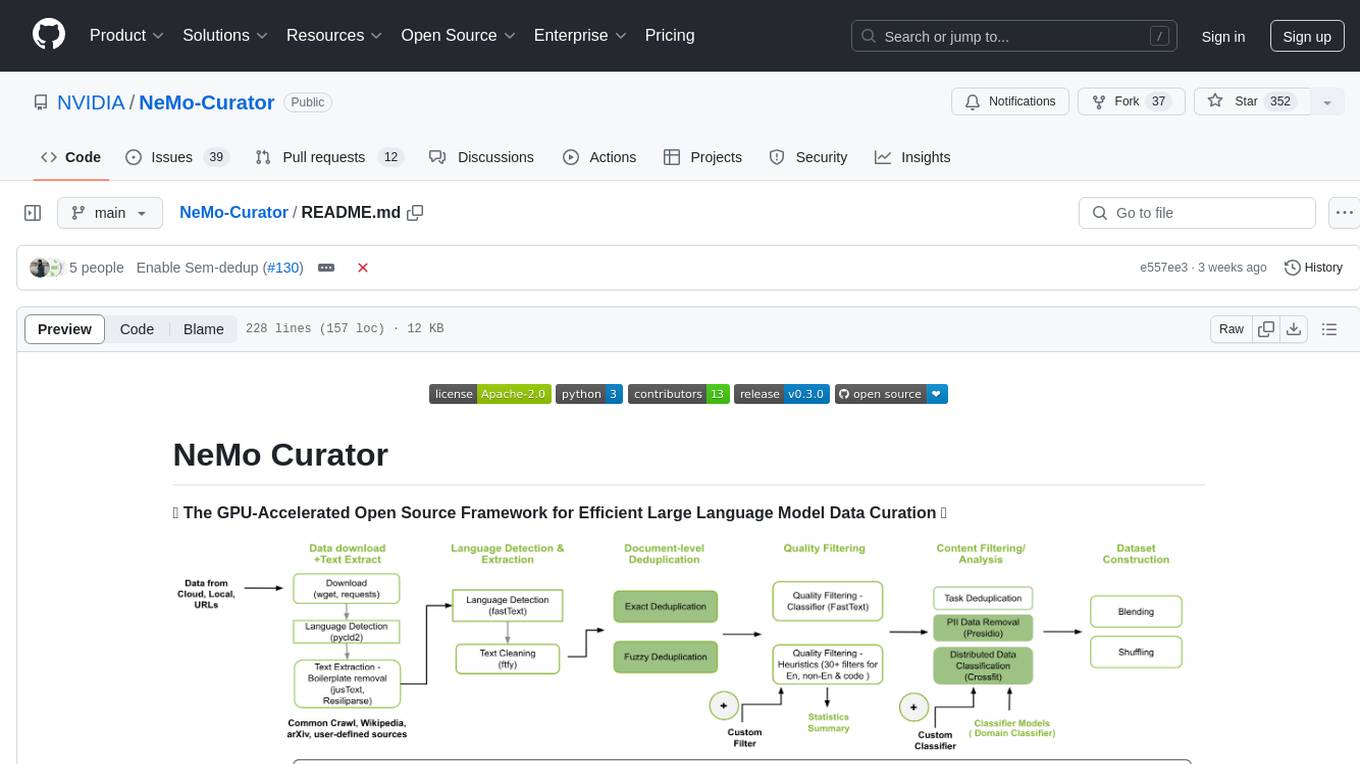
NeMo-Curator
NeMo Curator is a GPU-accelerated open-source framework designed for efficient large language model data curation. It provides scalable dataset preparation for tasks like foundation model pretraining, domain-adaptive pretraining, supervised fine-tuning, and parameter-efficient fine-tuning. The library leverages GPUs with Dask and RAPIDS to accelerate data curation, offering customizable and modular interfaces for pipeline expansion and model convergence. Key features include data download, text extraction, quality filtering, deduplication, downstream-task decontamination, distributed data classification, and PII redaction. NeMo Curator is suitable for curating high-quality datasets for large language model training.
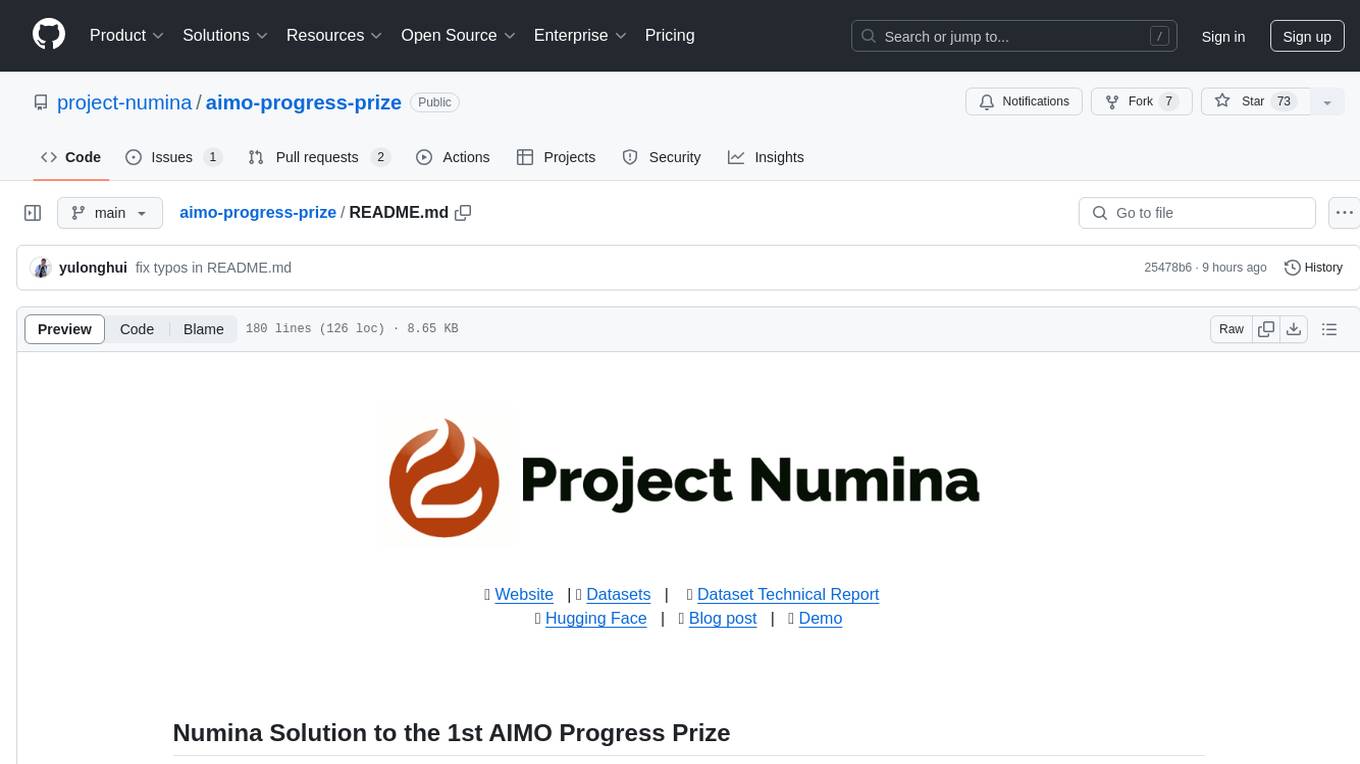
aimo-progress-prize
This repository contains the training and inference code needed to replicate the winning solution to the AI Mathematical Olympiad - Progress Prize 1. It consists of fine-tuning DeepSeekMath-Base 7B, high-quality training datasets, a self-consistency decoding algorithm, and carefully chosen validation sets. The training methodology involves Chain of Thought (CoT) and Tool Integrated Reasoning (TIR) training stages. Two datasets, NuminaMath-CoT and NuminaMath-TIR, were used to fine-tune the models. The models were trained using open-source libraries like TRL, PyTorch, vLLM, and DeepSpeed. Post-training quantization to 8-bit precision was done to improve performance on Kaggle's T4 GPUs. The project structure includes scripts for training, quantization, and inference, along with necessary installation instructions and hardware/software specifications.
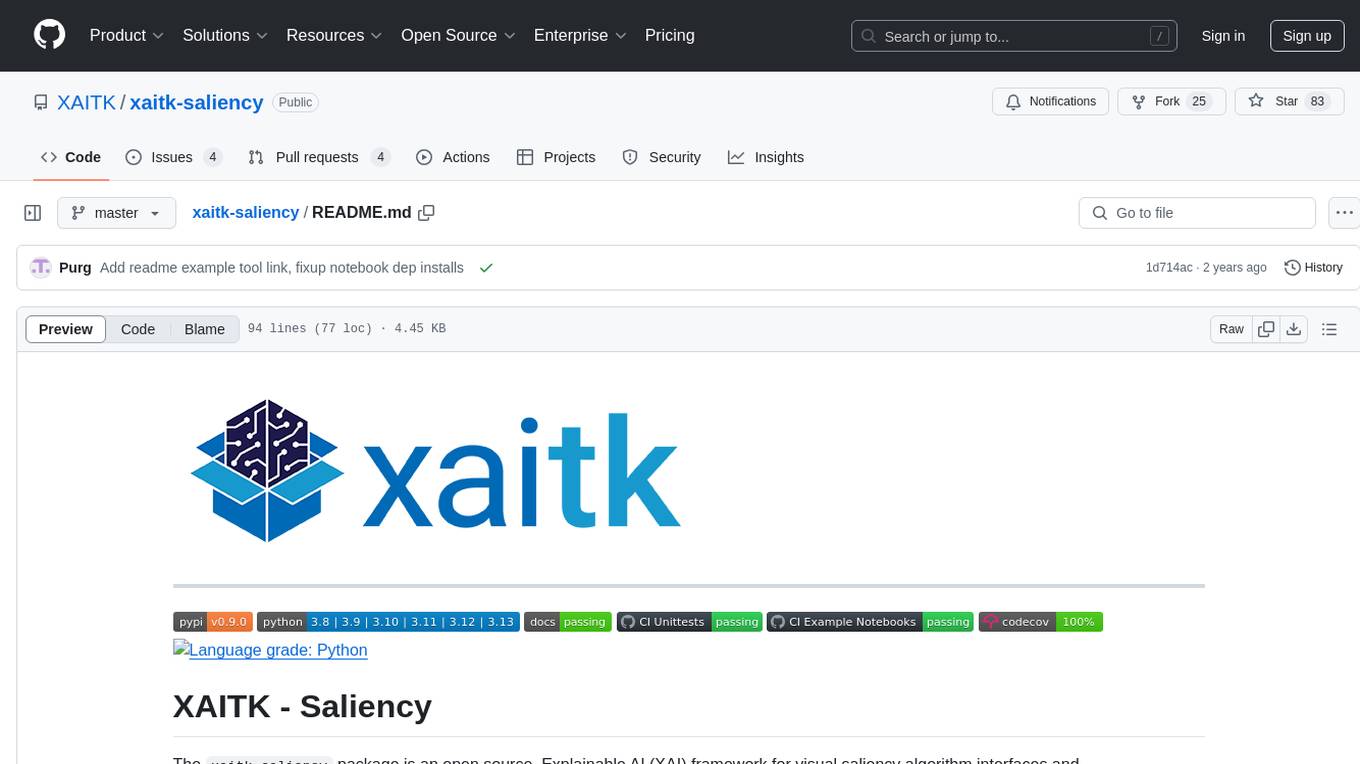
xaitk-saliency
The `xaitk-saliency` package is an open source Explainable AI (XAI) framework for visual saliency algorithm interfaces and implementations, designed for analytics and autonomy applications. It provides saliency algorithms for various image understanding tasks such as image classification, image similarity, object detection, and reinforcement learning. The toolkit targets data scientists and developers who aim to incorporate visual saliency explanations into their workflow or product, offering both direct accessibility for experimentation and modular integration into systems and applications through Strategy and Adapter patterns. The package includes documentation, examples, and a demonstration tool for visual saliency generation in a user-interface.
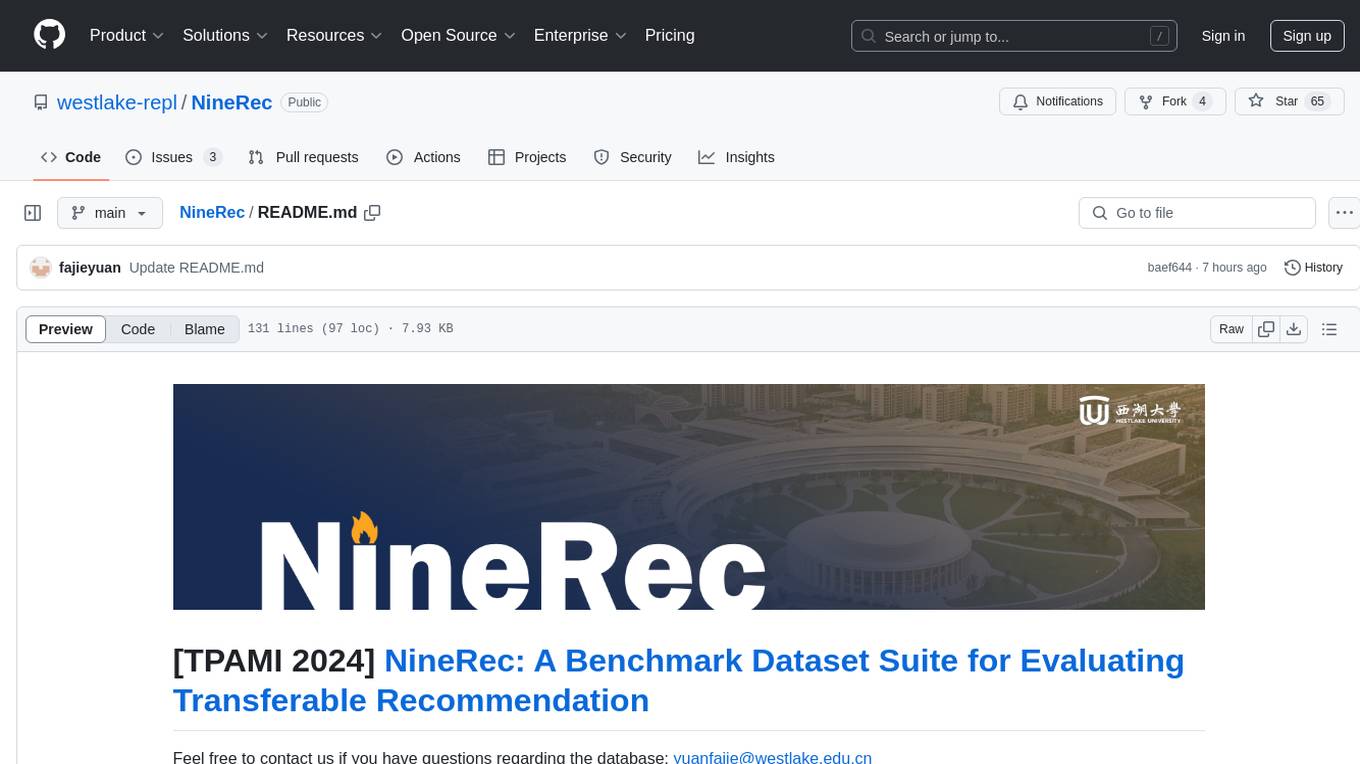
NineRec
NineRec is a benchmark dataset suite for evaluating transferable recommendation models. It provides datasets for pre-training and transfer learning in recommender systems, focusing on multimodal and foundation model tasks. The dataset includes user-item interactions, item texts in multiple languages, item URLs, and raw images. Researchers can use NineRec to develop more effective and efficient methods for pre-training recommendation models beyond end-to-end training. The dataset is accompanied by code for dataset preparation, training, and testing in PyTorch environment.
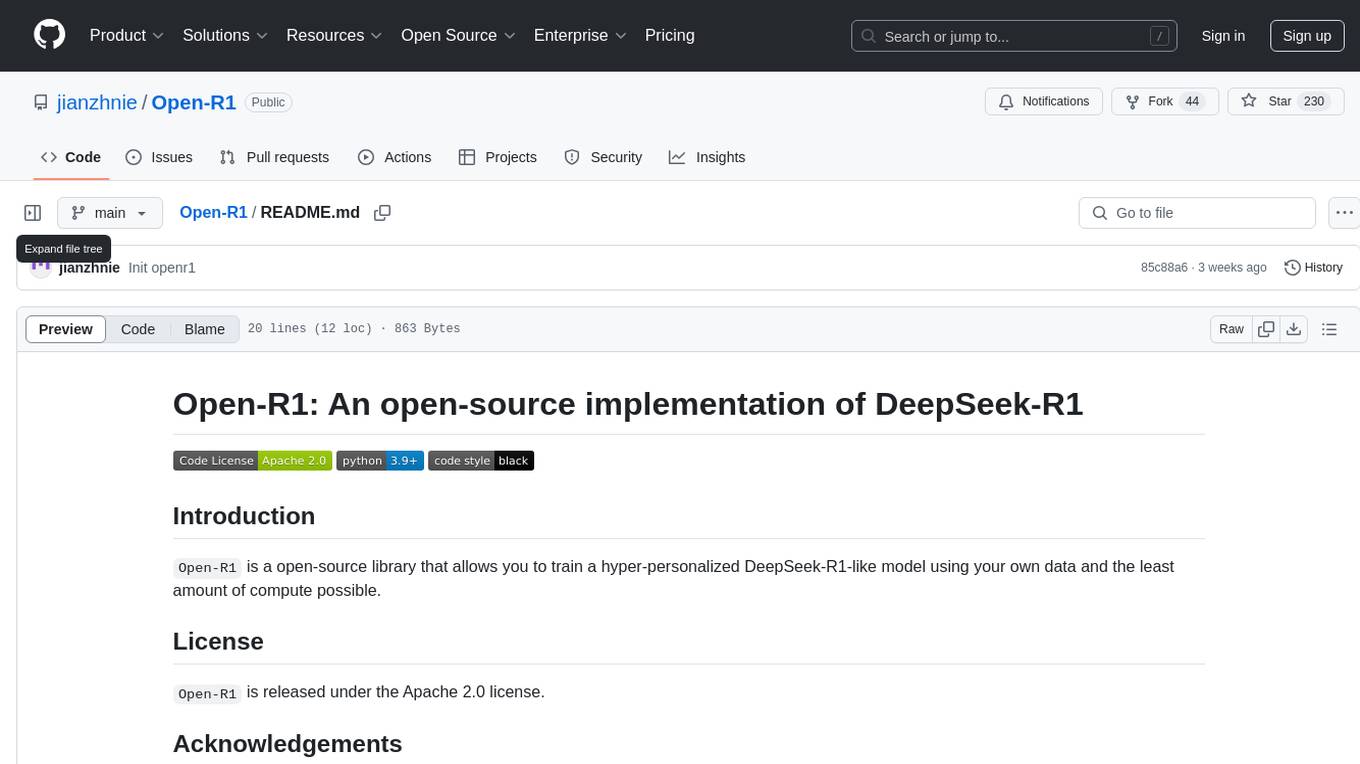
Open-R1
Open-R1 is an open-source library for training a hyper-personalized DeepSeek-R1-like model using minimal compute resources. It provides the flexibility to use your own data and aims to streamline the model training process. The project is licensed under Apache 2.0 and acknowledges contributions from various open-source contributors, including Hugging Face and Vicuna.
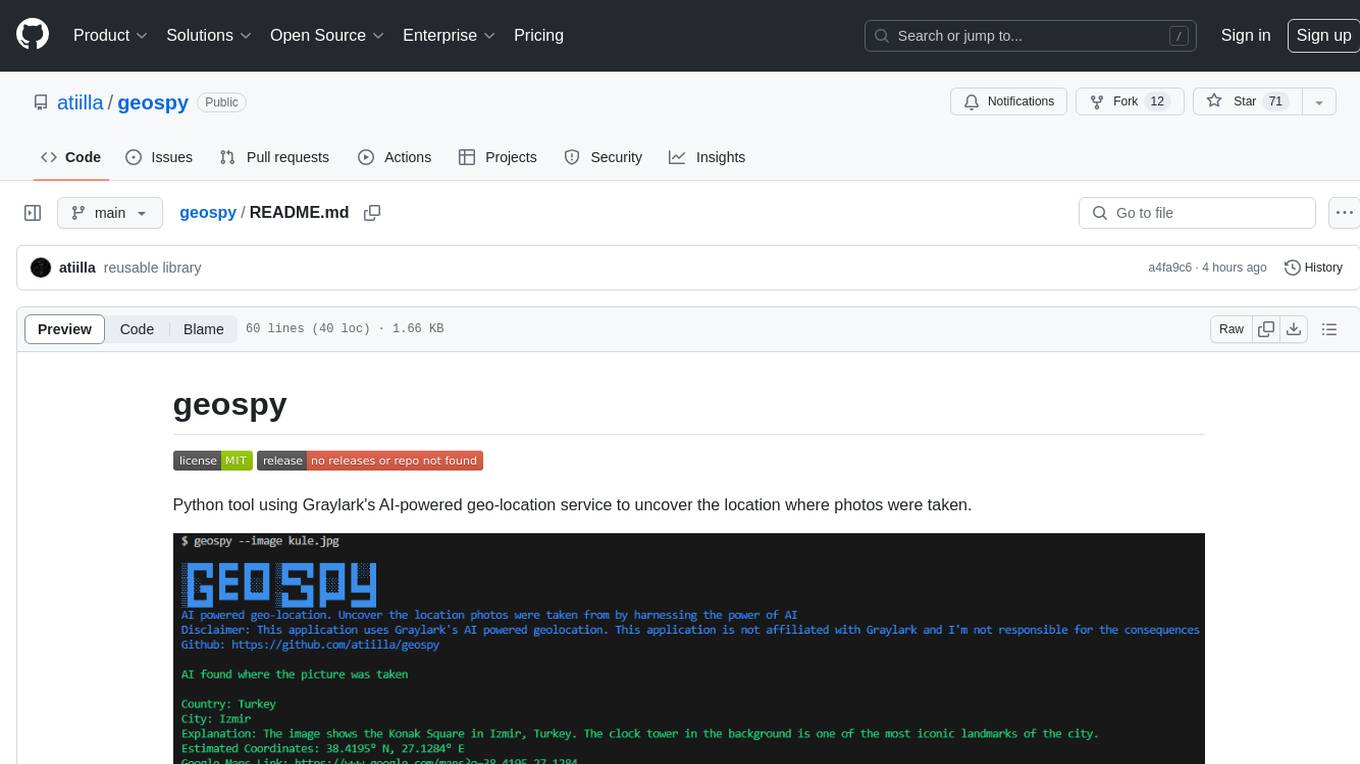
geospy
Geospy is a Python tool that utilizes Graylark's AI-powered geolocation service to determine the location where photos were taken. It allows users to analyze images and retrieve information such as country, city, explanation, coordinates, and Google Maps links. The tool provides a seamless way to integrate geolocation services into various projects and applications.
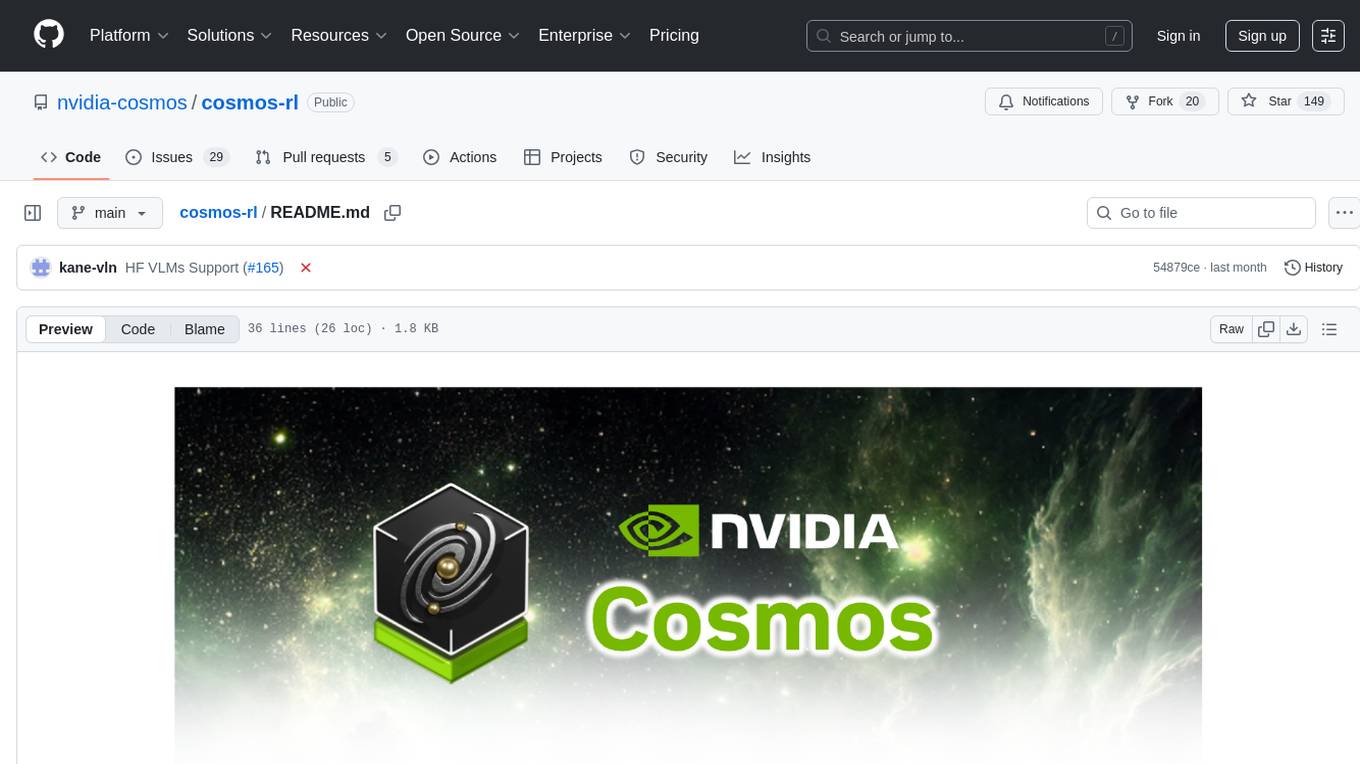
cosmos-rl
Cosmos-RL is a flexible and scalable Reinforcement Learning framework specialized for Physical AI applications. It provides a toolchain for large scale RL training workload with features like parallelism, asynchronous processing, low-precision training support, and a single-controller architecture. The system architecture includes Tensor Parallelism, Sequence Parallelism, Context Parallelism, FSDP Parallelism, and Pipeline Parallelism. It also utilizes a messaging system for coordinating policy and rollout replicas, along with dynamic NCCL Process Groups for fault-tolerant and elastic large-scale RL training.
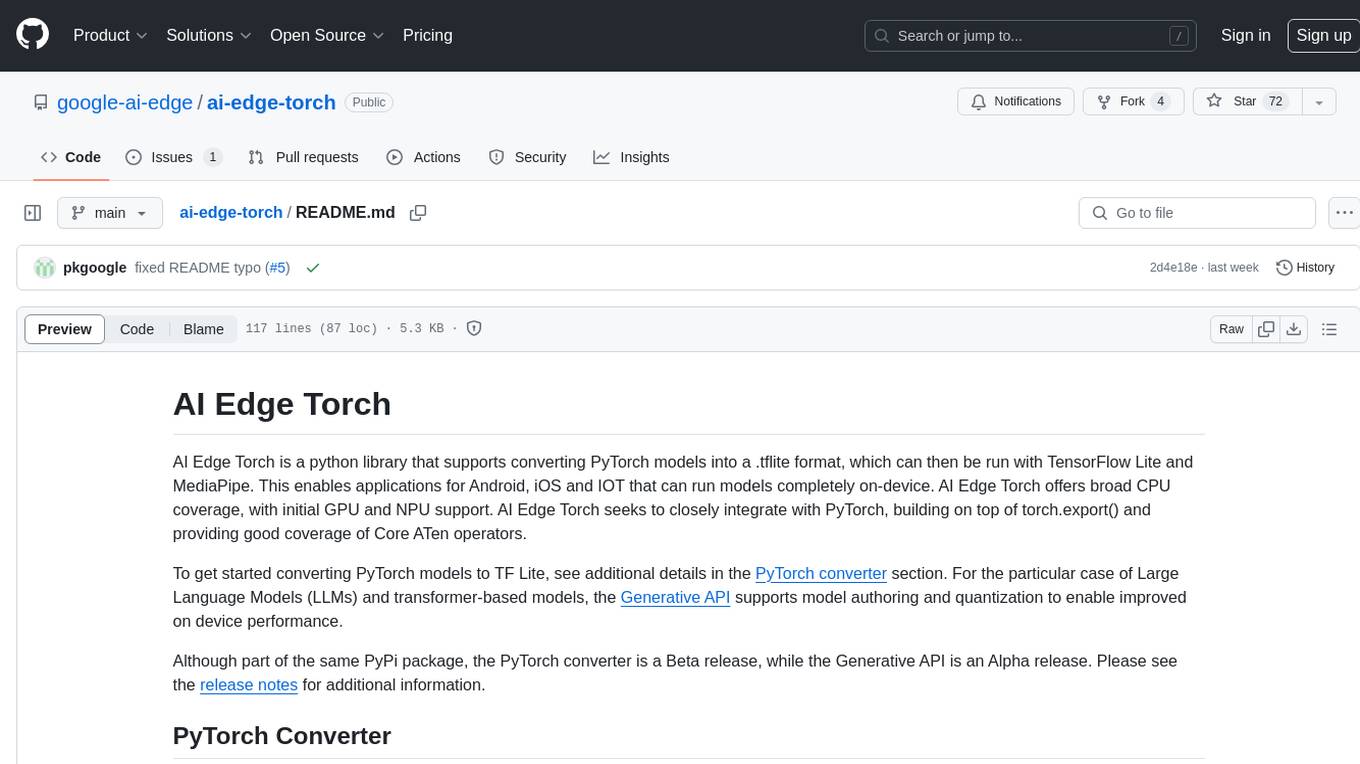
ai-edge-torch
AI Edge Torch is a Python library that supports converting PyTorch models into a .tflite format for on-device applications on Android, iOS, and IoT devices. It offers broad CPU coverage with initial GPU and NPU support, closely integrating with PyTorch and providing good coverage of Core ATen operators. The library includes a PyTorch converter for model conversion and a Generative API for authoring mobile-optimized PyTorch Transformer models, enabling easy deployment of Large Language Models (LLMs) on mobile devices.
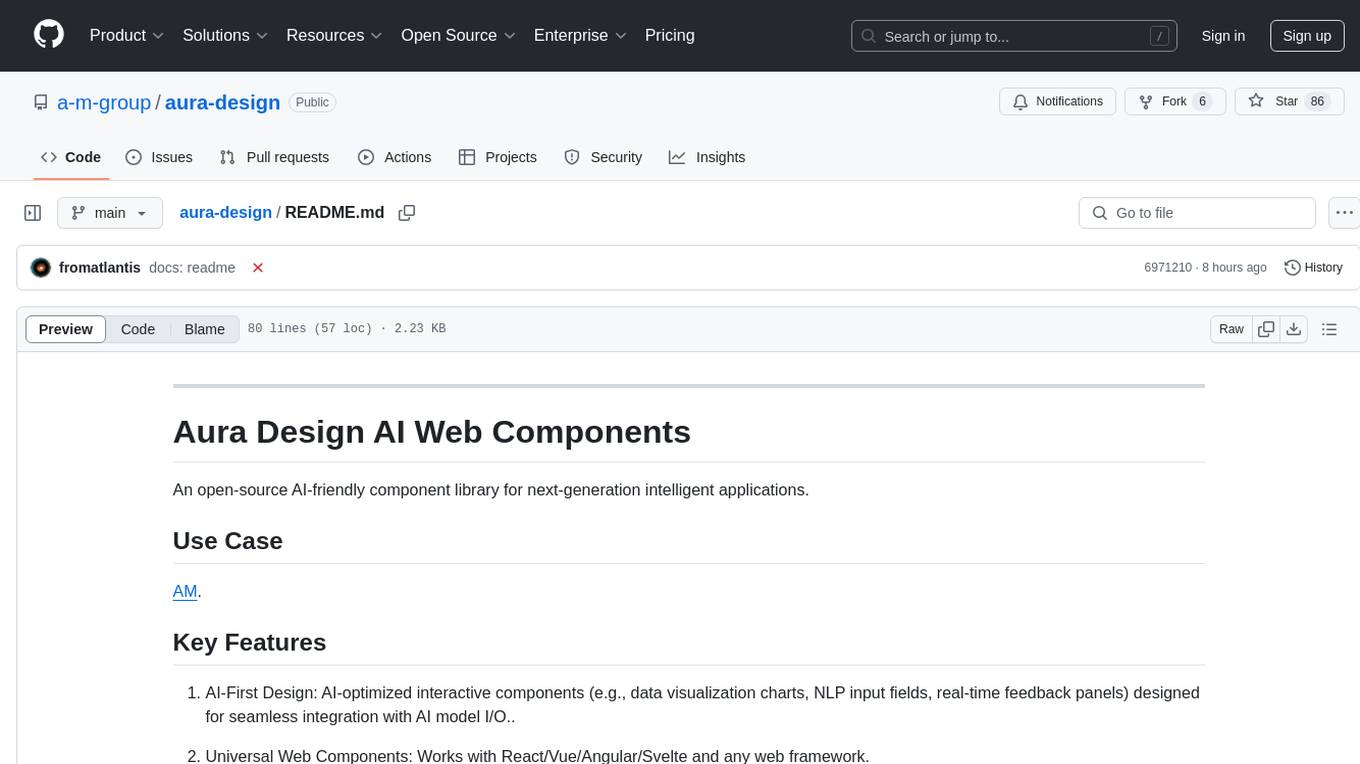
aura-design
Aura Design is an open-source AI-friendly component library for next-generation intelligent applications. It offers AI-optimized interactive components designed for seamless integration with AI model I/O. The library works with various web frameworks and allows easy customization to suit specific requirements. With a modern design and smart markdown renderer, Aura Design enhances the overall user experience.
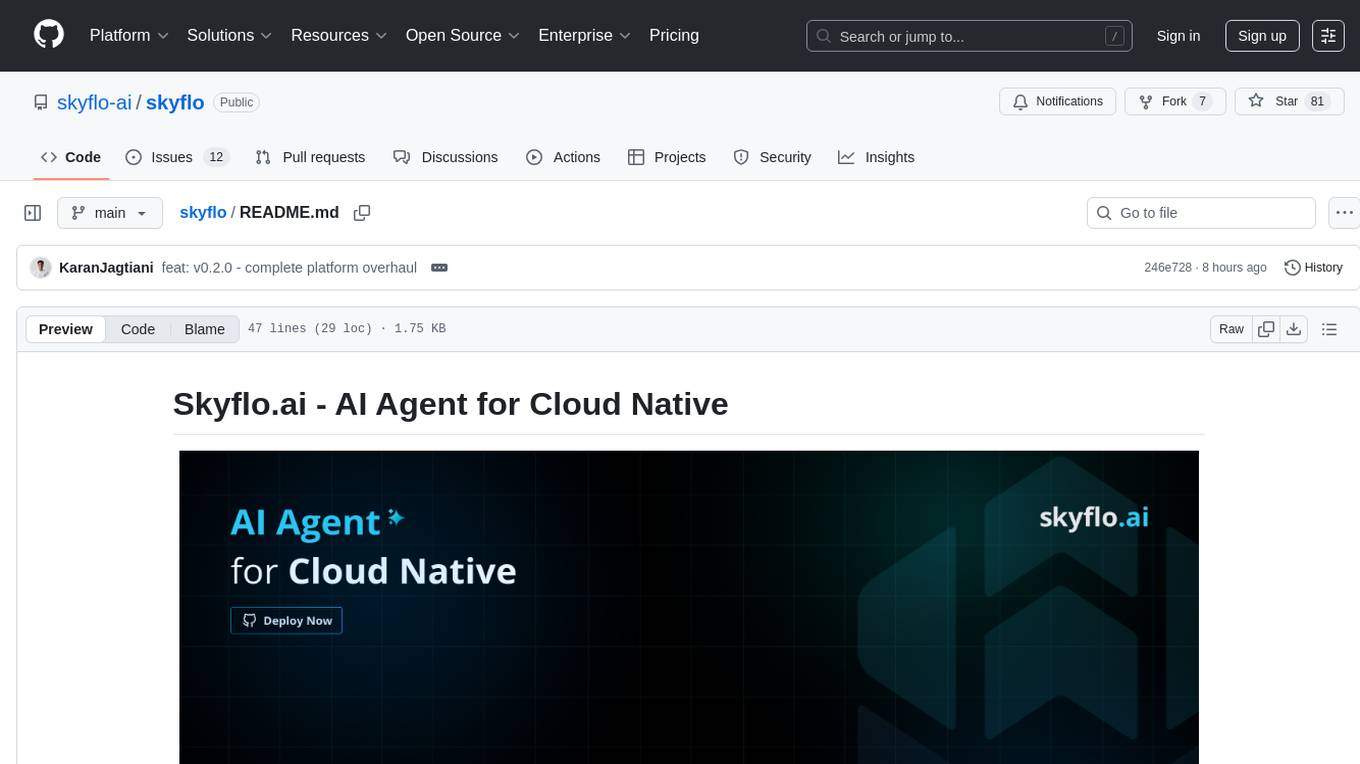
skyflo
Skyflo.ai is an AI agent designed for Cloud Native operations, providing seamless infrastructure management through natural language interactions. It serves as a safety-first co-pilot with a human-in-the-loop design. The tool offers flexible deployment options for both production and local Kubernetes environments, supporting various LLM providers and self-hosted models. Users can explore the architecture of Skyflo.ai and contribute to its development following the provided guidelines and Code of Conduct. The community engagement includes Discord, Twitter, YouTube, and GitHub Discussions.
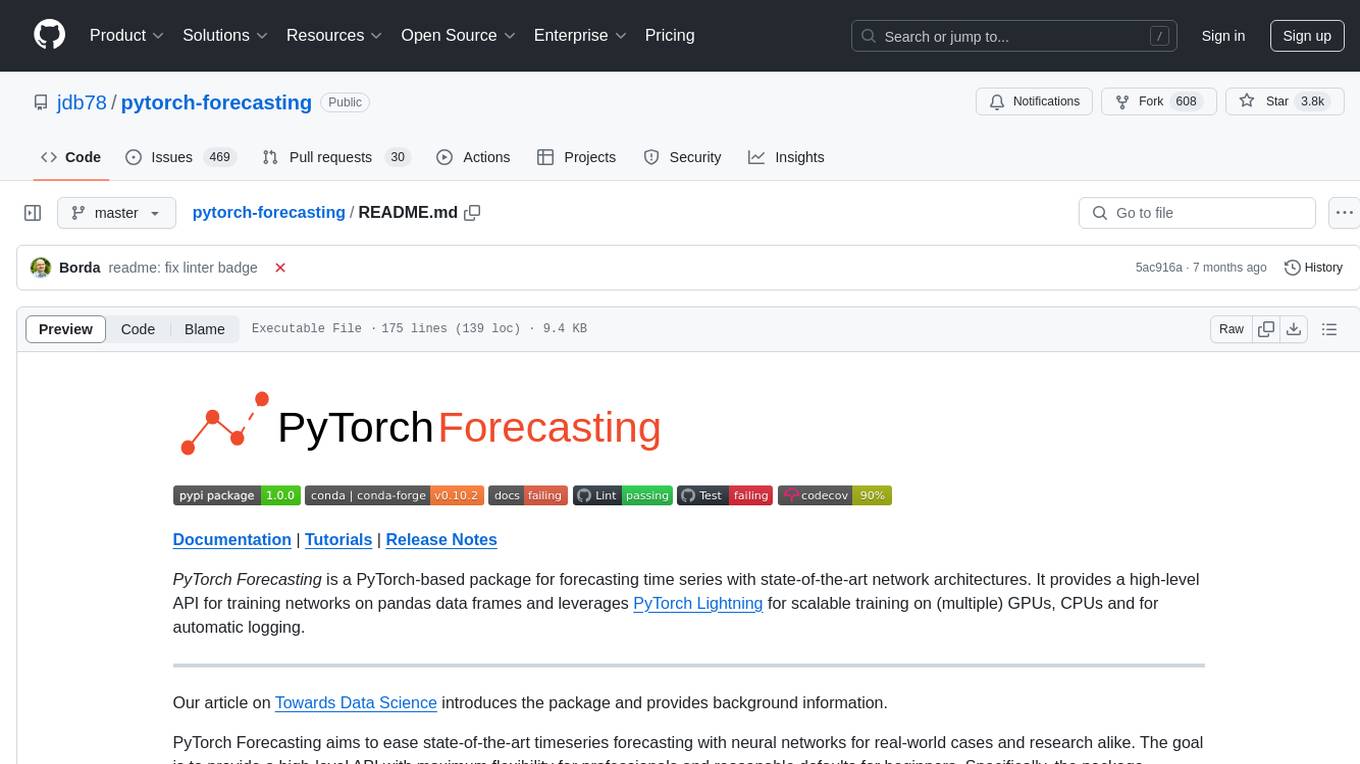
pytorch-forecasting
PyTorch Forecasting is a PyTorch-based package for time series forecasting with state-of-the-art network architectures. It offers a high-level API for training networks on pandas data frames and utilizes PyTorch Lightning for scalable training on GPUs and CPUs. The package aims to simplify time series forecasting with neural networks by providing a flexible API for professionals and default settings for beginners. It includes a timeseries dataset class, base model class, multiple neural network architectures, multi-horizon timeseries metrics, and hyperparameter tuning with optuna. PyTorch Forecasting is built on pytorch-lightning for easy training on various hardware configurations.
For similar tasks

aircraft
Headwind Simulations A339X - A330-900neo is an open-source project aimed at creating a free Airbus A330-900neo for Microsoft Flight Simulator. The project is based on the FlyByWire System A32NX and offers a detailed simulation of the A330-941 model with various components like engines, FMS, ACAS, ATC, and more. Users can build the aircraft using Docker and node modules, and the package can be easily integrated into MSFS. The project is part of a collaborative effort with other open-source projects contributing to the aircraft's systems, cockpit, sound, and 3D parts. The repository is dual-licensed under GNU GPLv3 for textual-form source code and CC BY-NC 4.0 for artistic assets, ensuring proper usage and attribution of the content.
For similar jobs
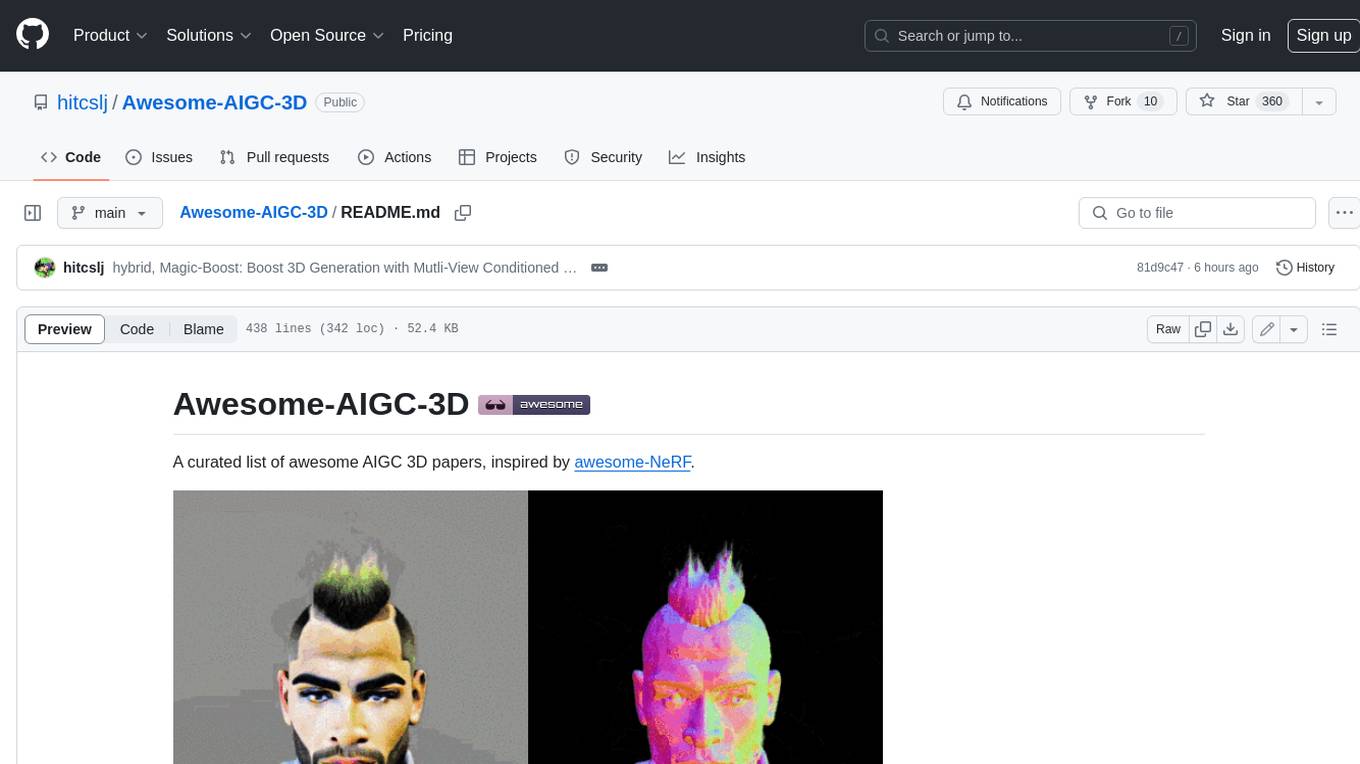
Awesome-AIGC-3D
Awesome-AIGC-3D is a curated list of awesome AIGC 3D papers, inspired by awesome-NeRF. It aims to provide a comprehensive overview of the state-of-the-art in AIGC 3D, including papers on text-to-3D generation, 3D scene generation, human avatar generation, and dynamic 3D generation. The repository also includes a list of benchmarks and datasets, talks, companies, and implementations related to AIGC 3D. The description is less than 400 words and provides a concise overview of the repository's content and purpose.

CushyStudio
CushyStudio is a generative AI platform designed for creatives of any level to effortlessly create stunning images, videos, and 3D models. It offers CushyApps, a collection of visual tools tailored for different artistic tasks, and CushyKit, an extensive toolkit for custom apps development and task automation. Users can dive into the AI revolution, unleash their creativity, share projects, and connect with a vibrant community. The platform aims to simplify the AI art creation process and provide a user-friendly environment for designing interfaces, adding custom logic, and accessing various tools.
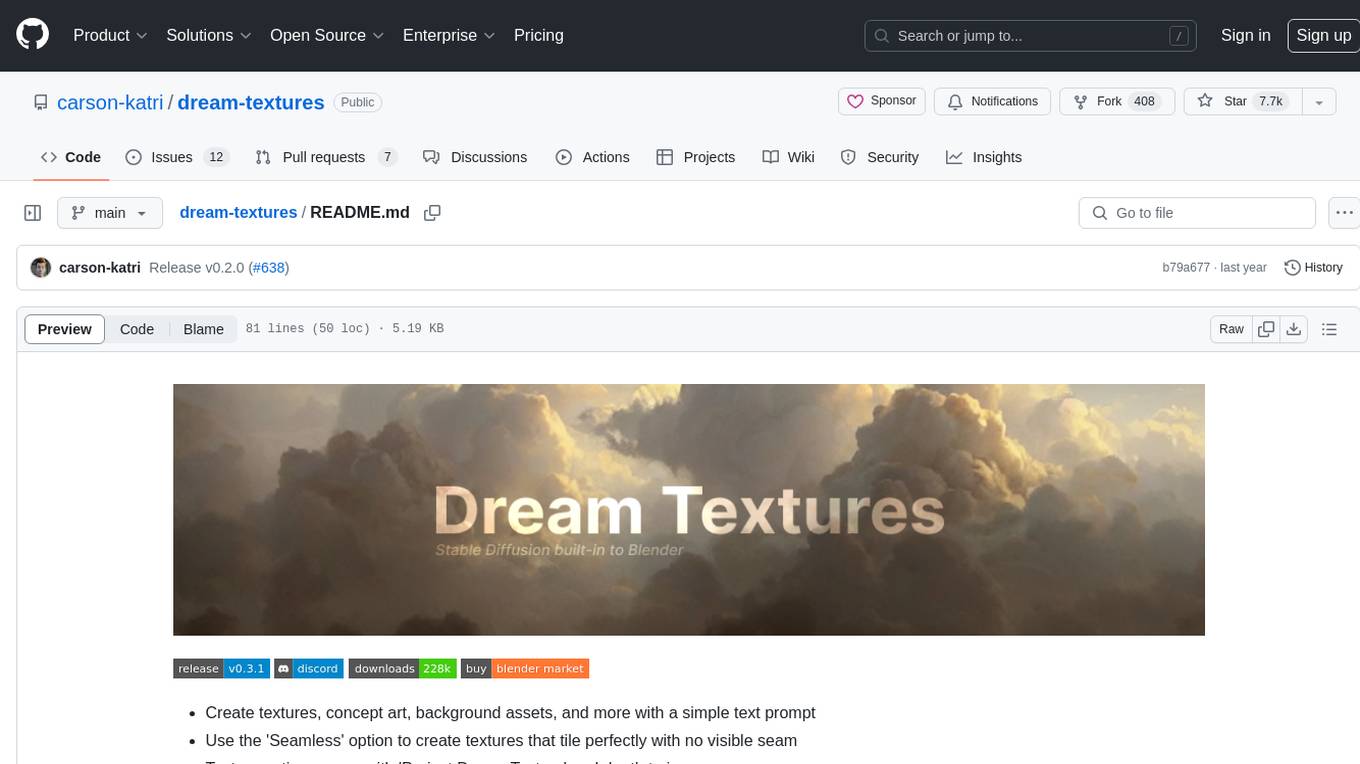
dream-textures
Dream Textures is a tool integrated into Blender that allows users to create textures, concept art, background assets, and more using simple text prompts. It offers features like seamless texture creation, texture projection for entire scenes, restyling animations, and running models on the user's machine for faster iteration. The tool supports CUDA and Apple Silicon GPUs, with over 4GB of VRAM recommended. Users can troubleshoot issues by checking Blender's system console or seeking help from the community on Discord.

aircraft
Headwind Simulations A339X - A330-900neo is an open-source project aimed at creating a free Airbus A330-900neo for Microsoft Flight Simulator. The project is based on the FlyByWire System A32NX and offers a detailed simulation of the A330-941 model with various components like engines, FMS, ACAS, ATC, and more. Users can build the aircraft using Docker and node modules, and the package can be easily integrated into MSFS. The project is part of a collaborative effort with other open-source projects contributing to the aircraft's systems, cockpit, sound, and 3D parts. The repository is dual-licensed under GNU GPLv3 for textual-form source code and CC BY-NC 4.0 for artistic assets, ensuring proper usage and attribution of the content.
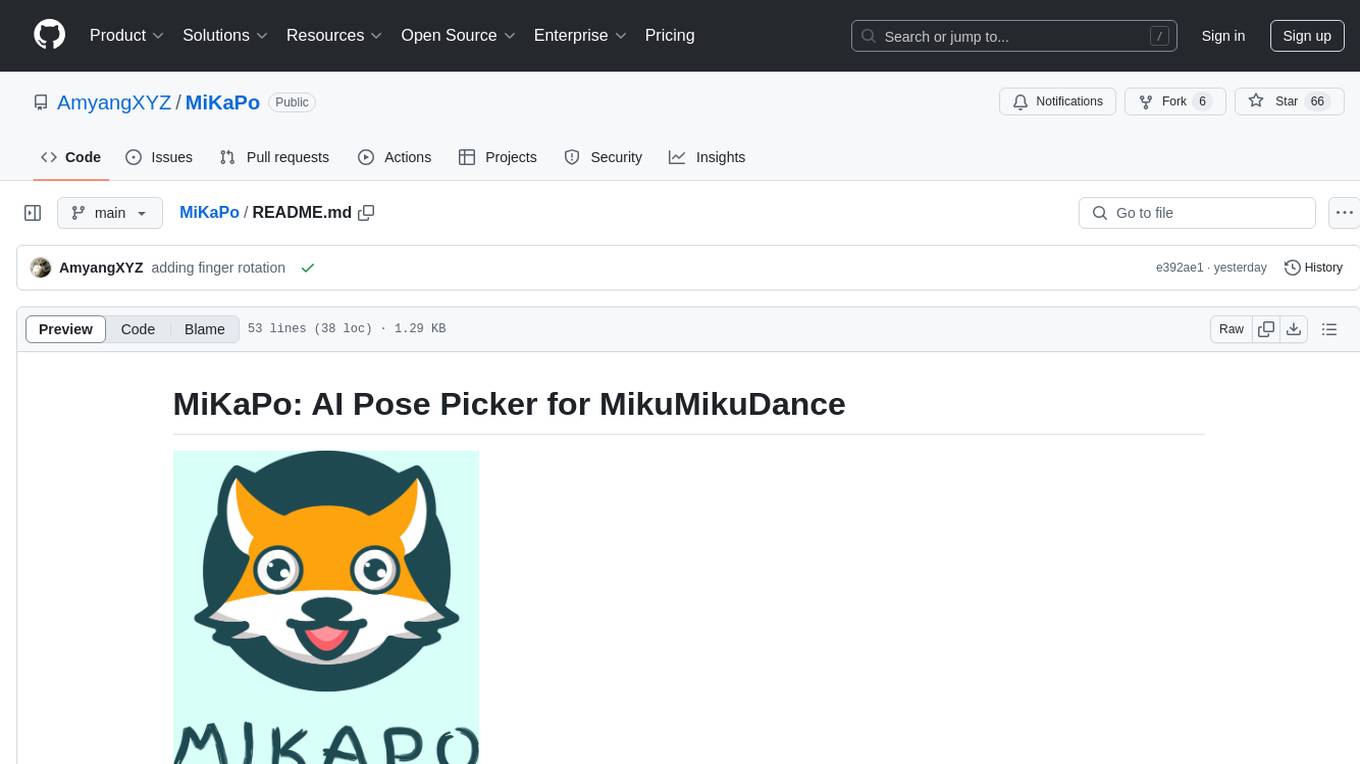
MiKaPo
MiKaPo is a web-based tool that allows users to pose MMD models in real-time using video input. It utilizes technologies such as Mediapipe for 3D key points detection, Babylon.js for 3D scene rendering, babylon-mmd for MMD model viewing, and Vite+React for the web framework. Users can upload videos and images, select different environments, and choose models for posing. MiKaPo also supports camera input and Ollama (electron version). The tool is open to feature requests and pull requests, with ongoing development to add VMD export functionality.
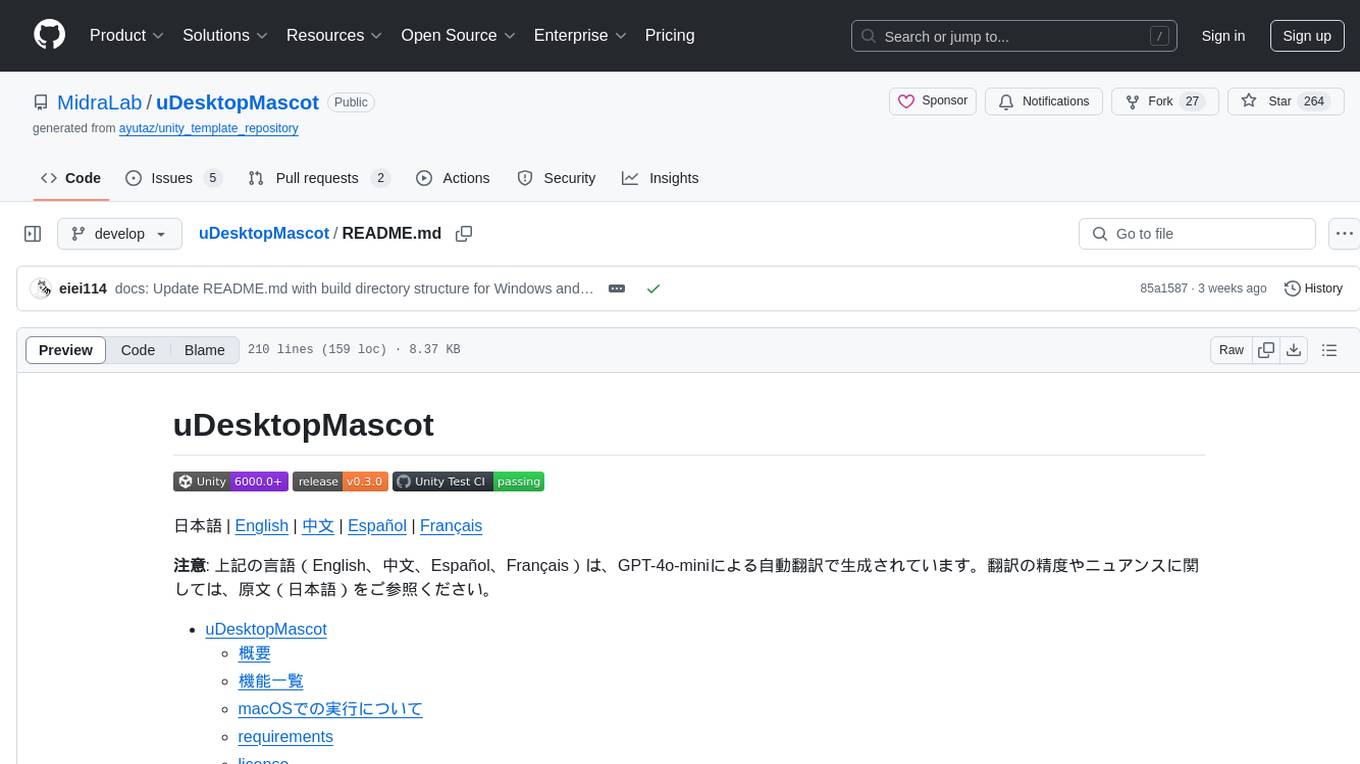
uDesktopMascot
uDesktopMascot is an open-source project for a desktop mascot application with a theme of 'freedom of creation'. It allows users to load and display VRM or GLB/FBX model files on the desktop, customize GUI colors and background images, and access various features through a menu screen. The application supports Windows 10/11 and macOS platforms.
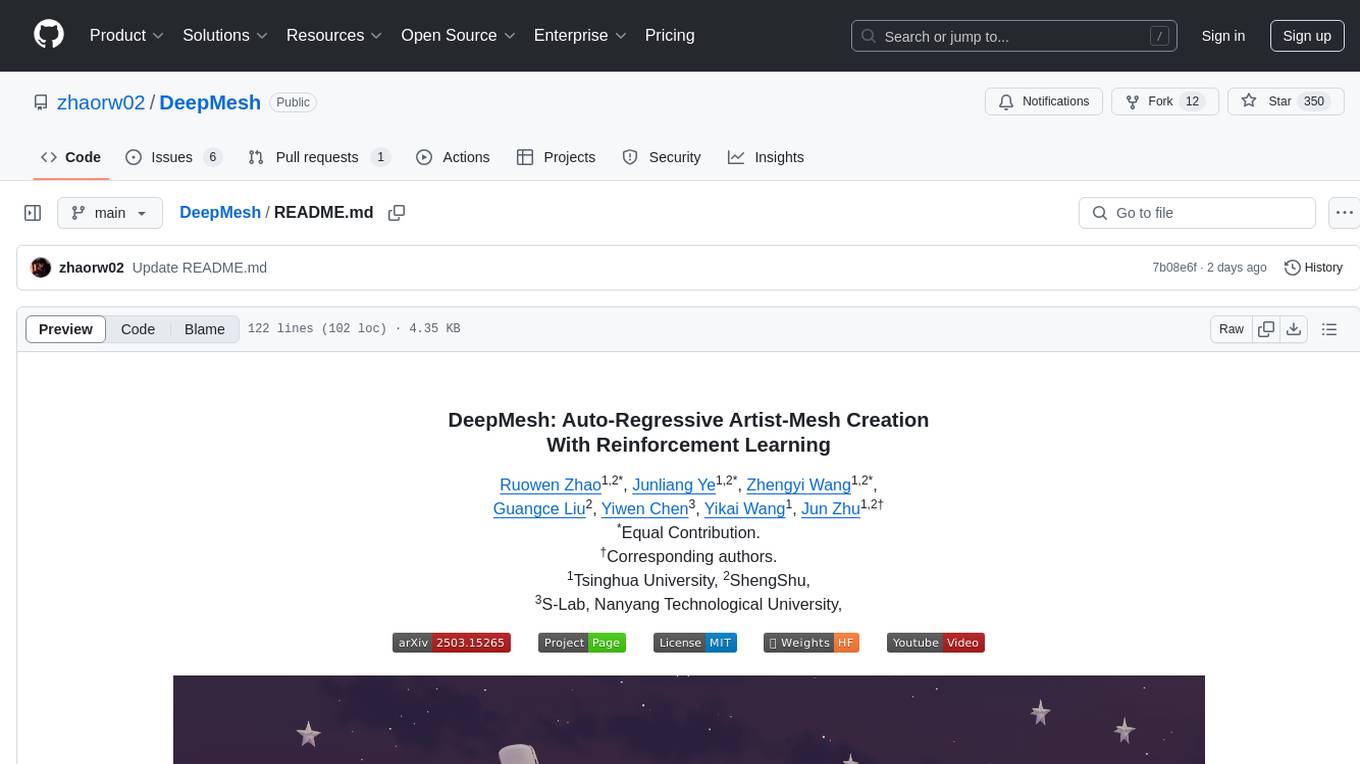
DeepMesh
DeepMesh is an auto-regressive artist-mesh creation tool that utilizes reinforcement learning to generate high-quality meshes conditioned on a given point cloud. It offers pretrained weights and allows users to generate obj/ply files based on specific input parameters. The tool has been tested on Ubuntu 22 with CUDA 11.8 and supports A100, A800, and A6000 GPUs. Users can clone the repository, create a conda environment, install pretrained model weights, and use command line inference to generate meshes.





